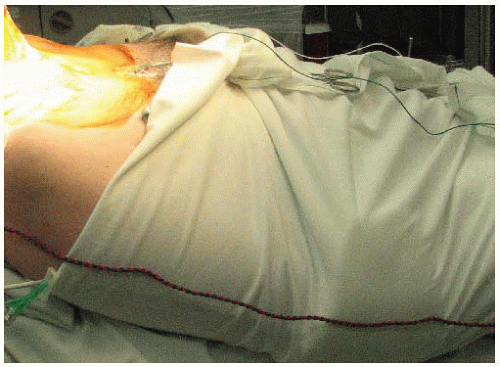Thyroid Lobectomy
Amy C. Fox
Paul G. Gauger
DEFINITION
Total thyroid lobectomy is defined as the surgical removal of an entire thyroid lobe and isthmus. It can be used as a diagnostic or a therapeutic procedure.
Thyroid disease requiring a lobectomy is most often due to the presence of a thyroid nodule. Palpable thyroid nodules are common and occur in 4% to 7% of the general population with an increased incidence with advanced age.1
The most common indications for a thyroid lobectomy are the following:
A thyroid nodule with diagnostic uncertainty
A symptomatic thyroid nodule (e.g., compressive unilateral goiter or autonomous toxic nodule)
DIFFERENTIAL DIAGNOSIS
Benign thyroid nodule
Toxic adenoma
Thyroid cancer
Intrathyroidal parathyroid adenoma
Lymph node
PATIENT HISTORY AND PHYSICAL FINDINGS
Although thyroid nodules are common, the vast majority of them are benign. A thorough patient history can assist the clinician in determining which thyroid nodules may require surgical management. Previous radiation to the neck, a rapidly growing mass, hoarseness, associated lymphadenopathy, or a family history of cancer may raise the suspicion of malignancy. Dysphagia, choking, or intolerance to things around the neck may suggest local compressive symptoms from a large thyroid nodule.
The physical exam should focus on characteristics of the thyroid such as size, firmness, and the presence of nodules. The neck should be palpated for associated lymphadenopathy.
IMAGING AND OTHER DIAGNOSTIC STUDIES
Thyroid function studies. A thyroid-stimulating hormone (TSH) can assess the biochemical status of the patient’s thyroid. A TSH should be obtained prior to any fine needle aspiration to ensure the patient is not hyperthyroid.
Ultrasonography. Neck ultrasound is a user dependent but highly sensitive adjunct in the evaluation of the thyroid and cervical lymphadenopathy. It can also assist in fine needle aspiration of thyroid nodules. A high-frequency probe of 7.5 MHz to 10 MHz is required.
Biopsy. Fine needle aspiration can help determine benign from potentially malignant nodules. It is often done using ultrasound guidance. The cytopathology results can be categorized according to the Bethesda system.2 These categories are associated with varying risks of malignancy allowing for different proposals for clinical management (Table 1).3
Computed tomography (CT). A preoperative neck or chest CT is usually not necessary except in specific situations:
Malignancy—A neck CT may suggest local invasion of the thyroid into surrounding structures such as the carotid artery, internal jugular vein, or trachea which could potentially modify the operative approach. A CT scan of the neck can also provide a detailed map of cervical lymphadenopathy. A chest CT can evaluate for metastatic disease.
Large goiters—A neck and chest CT scan can help determine the degree of tracheal obstruction or substernal extension of large goiters. Patients with clinical evidence of airway obstruction should have a CT to provide anatomic information to help manage a potentially difficult airway.
Laryngoscopy. Flexible laryngoscopy should be performed on all patients with hoarseness or a previous history of neck surgery. This provides a current assessment and baseline evaluation of bilateral vocal cords prior to surgery.
SURGICAL MANAGEMENT
Thyroid lobectomy is therapeutic for patients with a unilateral goiter or a solitary toxic nodule which is symptomatic.
Thyroid lobectomy is diagnostic and can potentially be therapeutic for patients with indeterminate thyroid nodules such as those categorized as “follicular lesions of undetermined significance,” “follicular neoplasms,” or “suspicious for malignancy.”
Although thyroid malignancy often warrants surgical intervention, thyroid lobectomy is typically not the standard of care. Total thyroidectomy is recommended for most thyroid malignancies greater than a centimeter in size. A thyroid lobectomy may sometimes be appropriate for very small (less than a centimeter) well-differentiated thyroid cancers in select patients.
In any thyroid lobectomy, the patient and surgeon should be prepared for the conversion to a total thyroidectomy if intraoperative findings dictate this need. If the patient was
not counseled of this possibility, the surgeon should complete the lobectomy and defer definitive management until appropriate consent from the patient.
Table 1: Thyroid Fine Needle Aspiration Classification Scheme and Clinical Management | |||||||||||||||||||||||||||
|---|---|---|---|---|---|---|---|---|---|---|---|---|---|---|---|---|---|---|---|---|---|---|---|---|---|---|---|
| |||||||||||||||||||||||||||
Preoperative Planning
Thyroid lobectomy is performed under a general anesthesia, but locoregional anesthetic with sedation may be adequate for lobectomy in select patients.
Routine use of preoperative antibiotics is not common as wound infections after thyroid lobectomy are rare.4
Positioning
The patient is placed in the supine position with the arms padded and tucked at the side (FIG 1). A roll can be placed under the shoulders to help extend the neck; however, extreme extension should be avoided as this can cause postoperative discomfort.
 FIG 1 • Patient positioning. The arms should be padded and can be tucked to the side with a sheet using a towel clip.
Stay updated, free articles. Join our Telegram channel
Full access? Get Clinical Tree
 Get Clinical Tree app for offline access
Get Clinical Tree app for offline access

|